Canon EOS 760D, EOS REBEL T6s Instruction Manual

EOS REBEL T6S (W)
EOS 760D (W)
Wi-Fi/NFC Function
Instruction Manual
E
INSTRUCTION MANUAL
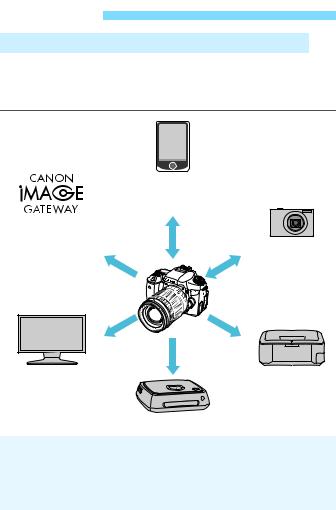
Introduction
What You Can Do Using the Wireless LAN Functions
This camera’s wireless LAN functions let you perform a range of tasks wirelessly, from sending images to Web services and other cameras to controlling the camera remotely, simply by connecting to a Wi-Fi network or other device supporting this camera’s wireless LAN functions.
(1) Connect to a smartphone
View images using a smartphone Shoot remotely with a smartphone
(CANON iMAGE GATEWAY)
(6)Send images to a Web service
Save and share images
(2)Transfer images between cameras
Exchange images
(5) View images using |
(3) Print images using |
a media player |
a Wi-Fi printer |
(4) Save images to Canon Connect Station
 CANON iMAGE GATEWAY Web services are not supported in certain countries and areas. For information on countries and areas supporting CANON iMAGE GATEWAY services, refer to the Canon Web site (http:// www.canon.com/cig).
CANON iMAGE GATEWAY Web services are not supported in certain countries and areas. For information on countries and areas supporting CANON iMAGE GATEWAY services, refer to the Canon Web site (http:// www.canon.com/cig).
Settings for “Send images to a Web service” may not be performed from a computer in certain countries and areas.
2

Introduction
(1)qConnect to a smartphone (p.25, 83)
View saved images or operate the camera from a Wi-Fi-enabled smartphone or tablet. Install the dedicated application “Camera Connect” to use these functions.
In this manual and on the camera’s LCD monitor, “smartphone” refers to smartphones and tablets.
(2)zTransfer images between cameras (p.43)
Transfer images between this camera and other Canon cameras with built-in wireless LAN functions.
(3)lPrint images using a Wi-Fi printer (p.53, 93)
Connect the camera to a wireless LAN compatible printer supporting PictBridge (Wireless LAN) to print images wirelessly.
(4)Save images to Connect Station (p.61)
Connect the camera to Connect Station (sold separately) via a wireless LAN to save images.
(5)oView images using a media player (p.101)
View images on the camera’s memory card on your TV set, by using a media player supporting DLNA* via a wireless LAN.
* Digital Living Network Alliance
(6)m Send images to a Web service (p.107)
Share images with family and friends or share images using a range of Web services via CANON iMAGE GATEWAY, an online photo service for Canon users (free registration required).
Easy Connection Using the NFC Function
This camera supports NFC which enables you to set up a connection between the camera and a smartphone or Connect Station (sold separately) easily. For details, see page 17.
3
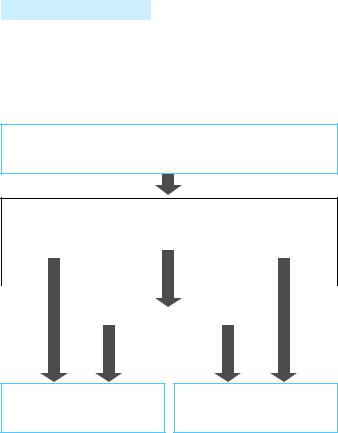
Structure of This Manual
This manual consists of “Getting Started”, “Easy Connection”, and “Advanced Connection”. After registering a nickname in Getting Started (p.19), see the following pages according to your needs.
z/Connect Station: “Easy Connection” (p.23)
o/m: “Advanced Connection” (p.65)
q/l: “Easy Connection” or “Advanced Connection” depending on your needs
Getting Started (p.11)
Explains the basic operations and how to register a nickname.
Selecting Connection Destination
zCamera |
|
|
q Smartphone |
|
o Media player |
|
Connect Station |
|
|
l Printer |
|
m Web service |
|
|
|
|
|
|
|
|
|
|
|
|
|
|
|
|
|
Select Connection Method |
|
|
||
|
For qor l, you can select the connection |
|
||||
|
method. |
|
|
|||
|
|
|
|
|
|
|
Easy Connection (p.23) Connect the camera directly to the device.
Advanced Connection (p.65) Connect using a Wi-Fi access point.
4

Chapters
|
Introduction |
2 |
|
|
|
||
|
|
|
|
Getting Started |
|
|
|
1 |
Basic Operation and Settings |
13 |
|
|
|||
|
|
|
|
|
|
|
|
2 |
Registering a Nickname |
19 |
|
|
|||
|
|
|
|
|
|
|
|
Easy Connection |
|
|
|
3 |
Easy Connection to a Smartphone |
25 |
|
|
|||
|
|
|
|
|
|
|
|
4 |
Transferring Images Between Cameras |
43 |
|
|
|||
|
|
|
|
|
|
|
|
5 |
Easy Connection to a Wi-Fi Printer |
53 |
|
|
|||
|
|
|
|
|
|
|
|
6 |
Easy Connection to Connect Station |
61 |
|
|
|||
|
|
|
|
|
|
|
|
Advanced Connection |
|
|
|
7 |
Using a Wi-Fi Access Point |
69 |
|
|
|||
|
|
|
|
|
|
|
|
8 |
Wi-Fi Connection to a Smartphone |
83 |
|
|
|||
|
|
|
|
|
|
|
|
9 |
Wi-Fi Connection to a Wi-Fi Printer |
93 |
|
|
|||
|
|
|
|
|
|
|
|
10 |
Viewing Images Using a Media Player |
101 |
|
|
|||
|
|
|
|
|
|
|
|
11 |
Wi-Fi Connection to a Web Service |
107 |
|
|
|||
|
|
|
|
|
|
|
|
12 |
Connecting to a Wireless LAN from a Playback Screen |
129 |
|
|
|||
|
|
|
|
|
|
|
|
13 |
Managing Settings |
133 |
|
|
|||
|
|
|
|
|
|
|
|
14 |
Troubleshooting Guide |
139 |
|
|
|||
|
|
|
|
|
|
|
|
15 |
Reference |
157 |
|
|
|||
|
|
|
|
|
|
|
|
5

Contents |
|
|
|
Introduction |
2 |
|
What You Can Do Using the Wireless LAN Functions..................... |
2 |
|
Structure of This Manual .................................................................. |
4 |
|
Chapters........................................................................................... |
5 |
|
Contents ........................................................................................... |
6 |
|
Conventions Used in this Manual................................................... |
10 |
Getting Started |
11 |
|
|
Operation Flowchart ....................................................................... |
12 |
1 |
Basic Operation and Settings |
13 |
|
Basic Operation and Settings......................................................... |
14 |
2 |
Registering a Nickname |
19 |
|
Registering a Nickname ................................................................. |
20 |
Easy Connection |
23 |
|
|
Wireless LAN Function Flowchart (Easy Connection).................... |
24 |
3 |
Easy Connection to a Smartphone |
25 |
|
Preparation..................................................................................... |
26 |
|
Connecting with the NFC Function................................................. |
28 |
|
Using Camera Access Point Mode to Establish a Connection....... |
31 |
|
Operating the Camera Using a Smartphone .................................. |
35 |
|
Reconnecting ................................................................................. |
37 |
|
Easy Image Transfer Using the NFC Function............................... |
39 |
6

|
|
Contents |
4 |
Transferring Images Between Cameras |
43 |
|
Selecting the Connection Destination ............................................. |
44 |
|
Sending Images .............................................................................. |
46 |
|
Reconnecting .................................................................................. |
50 |
|
Registering Multiple Connection Settings ....................................... |
51 |
5 |
Easy Connection to a Wi-Fi Printer |
53 |
|
Using Camera Access Point Mode to Establish a Connection ....... |
54 |
|
Printing............................................................................................ |
57 |
|
Reconnecting .................................................................................. |
60 |
6 |
Easy Connection to Connect Station |
61 |
|
Saving Images ................................................................................ |
62 |
Advanced Connection |
65 |
|
|
Wireless LAN Function Flowchart (Advanced Connection) ............ |
66 |
7 |
Using a Wi-Fi Access Point |
69 |
|
Checking the Type of Access Point ................................................ |
70 |
|
Connection via WPS (PBC Mode) .................................................. |
71 |
|
Connection via WPS (PIN Mode).................................................... |
74 |
|
Manual Connection by Searching Networks ................................... |
78 |
8 |
Wi-Fi Connection to a Smartphone |
83 |
|
Using Infrastructure Mode to Establish a Connection..................... |
84 |
|
Operating the Camera Using a Smartphone................................... |
86 |
|
Reconnecting .................................................................................. |
88 |
|
Specifying Viewable Images ........................................................... |
89 |
|
Registering Multiple Connection Settings ....................................... |
92 |
7

Contents |
|
|
9 |
Wi-Fi Connection to a Wi-Fi Printer |
93 |
|
Using Infrastructure Mode to Establish a Connection |
.................... 94 |
|
Printing ........................................................................................... |
95 |
|
Reconnecting ................................................................................. |
98 |
|
Registering Multiple Connection Settings....................................... |
99 |
10 |
Viewing Images Using a Media Player |
101 |
|
Displaying Images on a TV set..................................................... |
102 |
|
Reconnecting ............................................................................... |
104 |
|
Registering Multiple Connection Settings..................................... |
105 |
11 |
Wi-Fi Connection to a Web Service |
107 |
|
Preparation................................................................................... |
108 |
|
Checking the Type of Access Point.............................................. |
110 |
|
Connection via WPS (PBC Mode)................................................ |
111 |
|
Connection via WPS (PIN Mode) ................................................. |
114 |
|
Manual Connection by Searching Networks ................................ |
117 |
|
Sending Images to a Web Service ............................................... |
121 |
|
Reconnecting ............................................................................... |
126 |
|
Registering Multiple Connection Settings..................................... |
127 |
12 |
Connecting to a Wireless LAN from a Playback Screen 129 |
|
|
Connecting from a Playback Screen ............................................ |
130 |
13 |
Managing Settings |
133 |
|
Checking, Changing, or Deleting Settings.................................... |
134 |
|
Clearing Wireless LAN Settings ................................................... |
137 |
8

|
|
Contents |
14 |
Troubleshooting Guide |
139 |
|
Responding to Error Messages .................................................... |
140 |
|
Troubleshooting Guide.................................................................. |
153 |
|
Wireless LAN Notes...................................................................... |
154 |
|
Checking Network Settings........................................................... |
156 |
15 |
Reference |
157 |
|
Setting Network Manually ............................................................. |
158 |
|
Setting IP Address Manually......................................................... |
160 |
|
Specifications................................................................................ |
162 |
|
Wi-Fi (Wireless LAN) Precautions ................................................ |
163 |
|
Index ............................................................................................. |
165 |
9

Conventions Used in this Manual 
In this manual, the term “wireless LAN” is used as a general term for Wi-Fi and Canon’s original wireless communication functions.
The term “access point” indicates wireless LAN terminals (wireless LAN access points, wireless LAN routers, etc.) that relay wireless LAN connection.
Brackets [ ] indicate button names, icon names, or other software elements displayed on the computer or other device’s screen. Brackets also indicate camera menu items.
The ** (numbers) for “(p.**)” in this manual indicate reference page numbers for more information.
Sections of this manual labeled with the following symbols contain particular types of information as described below.
 : Warnings to prevent potential problems during operation.
: Warnings to prevent potential problems during operation.  : Supplemental information.
: Supplemental information.
Trademarks
Microsoft and Windows are trademarks or registered trademarks of Microsoft Corporation in the United States and/or other countries.
Macintosh and Mac OS are trademarks of Apple Inc., registered in the U.S. and other countries.
Wi-Fi is a registered trademark of the Wi-Fi Alliance.
Wi-Fi Certified, WPA, WPA2, and the Wi-Fi Certified logo are trademarks of the Wi-Fi Alliance.
WPS used on camera settings screens and in this manual stands for Wi-Fi Protected Setup.
UPnP is a trademark of the UPnP Implementers Corporation.
The N-Mark is a trademark or registered trademark of NFC Forum, Inc. in the United States and in other countries.
All other trademarks are the property of their respective owners.
Note that Canon cannot be held liable for any loss or damage from erroneous wireless LAN settings for using the camera. In addition, Canon cannot be held liable for any other loss or damage caused by use of the camera.
When using Wi-Fi functions, establish appropriate security at your own risk and discretion. Canon cannot be held liable for any loss or damage caused by unauthorized access or other security breaches.
10

Getting Started
11
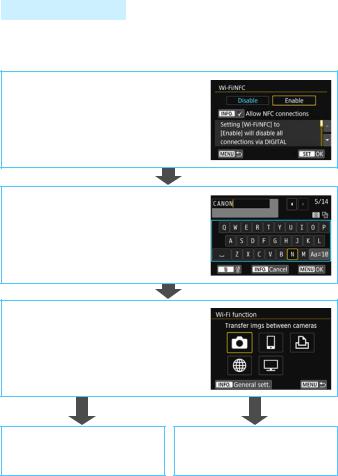
Operation Flowchart
This section explains the basic operation of the wireless LAN functions and how to register a nickname (for identification).
Follow the procedures below.
Set [Wi-Fi/NFC] to [Enable].
(Steps 1 and 2 on page 14)
When this setting is selected for the first time, a screen to register a nickname is displayed.
Register a nickname. (p.20)
Set the camera’s nickname. Enter any characters between 1 to 14 characters in length, such as your name.
Be sure to set a nickname as otherwise you cannot go to the wireless LAN settings screen.
Display the [Wi-Fi function] screen.
(Steps 3 and 4 on pages 14-15)
The camera’s wireless LAN settings are set from the [Wi-Fi function] screen.
For further settings, see “Easy Connection” or “Advanced Connection”.
Easy Connection (p.23) Connect the camera directly to the device.
Advanced Connection (p.65) Connect using a Wi-Fi access point.
12

1
Basic Operation and Settings
This chapter describes the basic operation and settings necessary for using the camera’s wireless LAN functions.
13
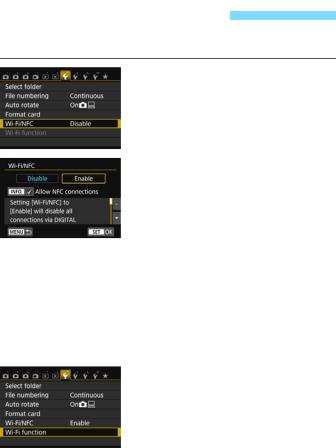
Basic Operation and Settings 
The basic operation for setting the camera’s wireless LAN functions is explained here. Follow the procedures below.
1
2
Select [Wi-Fi/NFC].
Under the [51] tab, select [Wi-Fi/ NFC], then press <0>.
Select [Enable].
Press the <Z> key to select [Enable], then press <0>.
When this setting is selected for the first time, a screen to register a nickname (for identification) is displayed. See page 20 to register a nickname.
[Wi-Fi function] under the [51] tab is now selectable.
When it is set to [Enable], all connections via the DIGITAL and HDMI terminals will be disabled. [Eye-Fi trans.] will be set to [Disable].
3Select [Wi-Fi function].
Under the [51] tab, select [Wi-Fi function], then press <0>.
14

Basic Operation and Settings
4Select the Wi-Fi function to connect to.
Press the <W> <X> or <Y> <Z> keys to select an item.
The camera’s wireless LAN settings are set from this screen. For further connection settings, see “Easy Connection” or “Advanced Connection”.
[Wi-Fi/NFC]
When it is set to [Disable], you cannot select [Wi-Fi function] under the [51] tab.
When using the NFC function, set [Wi-Fi/NFC] to [Enable], then add [X] to [Allow NFC connections]. Press the <B> button to add or remove [X].
When the use of electronic devices and wireless devices is prohibited, such as on board airplanes or in hospitals, set it to [Disable].
When it is set to [Enable], you cannot use the camera by connecting it to a computer, printer, GPS receiver, TV set, or other device with a cable (p.18).
Using the Camera While Wireless LAN Functions Are Active
When you want to prioritize wireless LAN functions, do not operate the power switch, Mode Dial, card slot cover, or battery compartment cover. Otherwise, shooting or playback operation may be prioritized and wireless LAN functions may be terminated during the process.
15

Basic Operation and Settings
Auto Power Off
If necessary, set [Auto power off] under the [52] tab to [Disable].
If the camera’s auto power off is activated during the wireless LAN connection, the connection will be terminated.
Wireless LAN Connection Status
Wireless LAN connection status can be checked on the camera’s LCD panel.
 Wi-Fi function
Wi-Fi function
Connection Status |
Wi-Fi Function |
|
Display |
||
|
||
Not connected |
(Off) |
|
|
||
|
||
|
|
|
Connected/Sending data/ |
|
|
Receiving data |
|
|
|
|
|
Waiting for connection/Waiting for |
(Blinking) |
|
|
||
reconnection |
|
|
|
||
|
|
|
Connection error |
(Blinking) |
|
|
||
(Blinking) |
||
|
||
|
|
16

Basic Operation and Settings
Touch Control
You can operate wireless LAN functions by touching the camera’s screen as well.
What You Can Do Using the NFC Function
Using the camera’s NFC function enables you to do the following:
Touch an NFC-enabled smartphone to the camera to connect them easily via a wireless LAN (p.28).
While playing back images on the camera, touch an NFC-enabled smartphone to the camera to send a captured image to the smartphone (p.39).
Hold the camera close to the Canon Connect Station (sold separately) to connect them easily via a wireless LAN (p.62).
 With this camera, you cannot connect to other NFC-enabled cameras or printers using the NFC function.
With this camera, you cannot connect to other NFC-enabled cameras or printers using the NFC function.
What is NFC?
NFC (Near Field Communication) is a function that can exchange information by simply bringing two NFC-enabled devices close together. This camera uses the NFC function to exchange information regarding wireless LAN connection.
17

Basic Operation and Settings
 Cable Connection Cautions
Cable Connection Cautions
When [51: Wi-Fi/NFC] is set to [Enable], connection via interface cable, stereo AV cable, or HDMI cable is disabled. Set [51: Wi-Fi/NFC] to [Disable] before connecting a cable.
When the camera is connected to a computer, printer, GPS receiver, TV set, or any other device with an interface cable, settings for [Wi-Fi/NFC]
cannot be changed. Disconnect the interface cable before changing any settings.
Cards
If there is no card in the camera, it cannot be connected to a wireless LAN. Additionally, the camera cannot be connected to a wireless LAN to use the Wi-Fi functions [l], [m], or [o] unless the card has images
saved on it.
Using an Eye-Fi Card
When [51: Wi-Fi/NFC] is set to [Enable], image transfer using an Eye-Fi card is disabled.
18

2
Registering a Nickname
This chapter describes how to set the camera’s nickname (for identification).
19
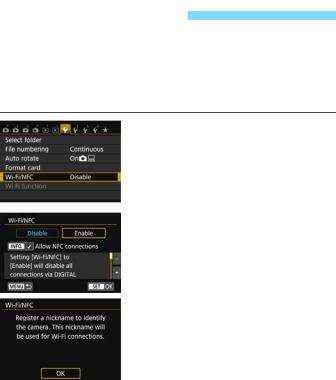
Registering a Nickname
Before setting up a connection, set the camera’s nickname (for identification).
When the camera is connected to another device via a wireless LAN, the nickname will be displayed on the device. Be sure to set a nickname as otherwise you cannot go to the wireless LAN settings screen.
1
2
Select [Wi-Fi/NFC].
Under the [51] tab, select [Wi-Fi/ NFC], then press <0>.
Select [Enable].
Press the <Z> key to select [Enable], then press <0>.
When this setting is selected for the first time, a screen to register a nickname is displayed. Select [OK] and proceed on to step 3.
20
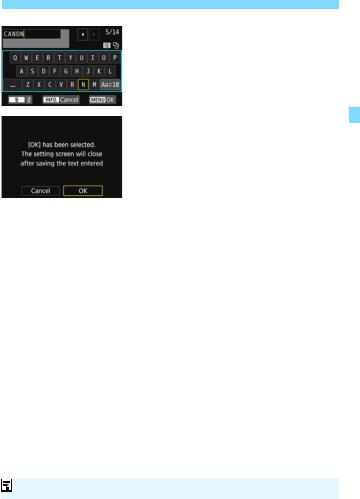
Registering a Nickname
3Enter a nickname.
For instructions on entering characters, see “Virtual Keyboard Operation” on the next page.
Enter any characters between 1 to 14 characters in length.
4Exit the setting.
When you are finished, press the <M> button.
Select [OK] on the confirmation dialog and press <0> to return to the menu screen.
The nickname can be changed later from the [General sett.] screen (p.138).
21

Registering a Nickname
Virtual Keyboard Operation
Changing the entry area
Press the <Q> button to toggle between the top and bottom entry areas.
Moving the cursor
Press the <Y> <Z> keys in the top area to move the cursor.
Entering text
In the bottom area, press the <W> <X> or <Y> <Z> keys to select a character, then press <0> to enter it.
You can check how many characters you have entered, and how many more can be entered, by referring to [*/*] on the upper right of the screen.
Changing the entry mode*
Select [E] at the bottom right of the bottom entry area. Each time you press <0>, the entry mode will change as follows: Lower case 9 Numerals / Symbols 1 9 Numerals / Symbols 2 9 Upper case.
*When [Touch control: Disable] is set, you can enter all characters on one screen.
Deleting a character
Press the <L> button to delete one character.
Finishing the text entry
Press the <M> button to confirm what you have entered and exit. If a confirmation dialog is displayed, select [OK] to exit.
Canceling the text entry
Press the <B> button to cancel text entry and exit. If a confirmation dialog is displayed, select [OK] to exit.
22

Easy Connection
23
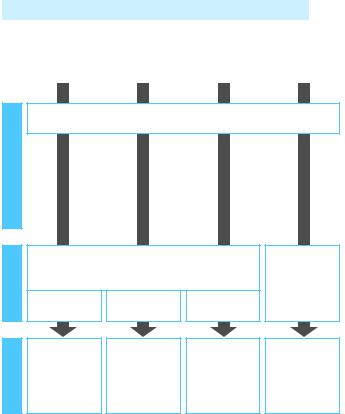
Wireless LAN Function Flowchart (Easy Connection)
Set up
q |
z |
l |
Connect |
|
|
|
|
Smartphone |
Camera |
Printer |
Station |
Register the camera’s nickname (p.20)
Install Camera |
|
Set up |
|
Set up |
|
Set up |
Connect on |
|
|
|
|||
|
a compatible |
|
a compatible |
|
||
a smartphone |
|
|
|
Connect Station |
||
|
camera (p.43) |
|
printer (p.53) |
|
||
(p.26) |
|
|
|
|
||
|
|
|
|
|
|
|
|
|
|
|
|
|
|
Connect |
Register connection destinations to the camera |
Connect via |
||
|
|
|
||
|
|
|
|
NFC (p.62) |
|
(p.28, 31) |
(p.44) |
(p.54) |
|
|
Make images |
|
|
|
Use |
viewable |
Exchange |
Print images |
Save images |
and shoot |
images (p.46) |
(p.57) |
(p.62) |
|
|
remotely (p.35) |
|
|
|
To connect to o(View images using a media player) or m(Send images to a Web service), see “Advanced Connection” (p.65).
24

3
Easy Connection to a Smartphone
Connecting the camera to a smartphone enables you to do the following:
•View or manage images stored in the camera with the smartphone.
•Receive images stored in the camera with the smartphone.
•Operate the camera with the smartphone and take a picture.
To connect using a Wi-Fi access point, see “Advanced Connection” (p.65).
 The camera cannot be connected to a smartphone when the power switch is set to <k>.
The camera cannot be connected to a smartphone when the power switch is set to <k>.
25

Preparation
Install Camera Connect on a Smartphone
To communicate with a smartphone, the dedicated smartphone application Camera Connect (free of charge) is necessary.
Camera Connect can be downloaded from the App Store or Google Play. Install Camera Connect on the smartphone and then perform the procedures to establish the connection.
To use Camera Connect, a smartphone on which iOS or Android installed is necessary. For information on supported operating systems, refer to the download site of Camera Connect.
When an NFC-enabled smartphone on which Camera Connect is not installed is touched to the camera, the download screen of Camera Connect will be displayed on the smartphone.
Interface or functions of Camera Connect are subject to change, for application improvement or update. In such a case, features of Camera Connect may differ from sample screens or operation instructions in this manual.
26

Preparation
Connection Method
When using an Android smartphone (OS version 4.0 or later), check if it is NFC-enabled.
When the smartphone is NFC-enabled: See p.28
You can easily set up a connection using the NFC function.
When the smartphone is not NFC-enabled: See p.31
Set up a connection in camera access point mode.
Smartphones labeled with the pmark are NFC-enabled. Some smartphones are not labeled with the pmark even if they are NFCenabled; if you do not know whether your smartphone is NFC-enabled, contact the manufacturer of the smartphone.
NFC-enabled smartphones can also be connected in camera access point mode or infrastructure mode.
27
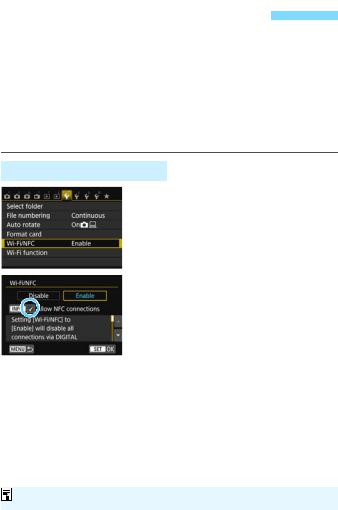
Connecting with the NFC Function 
Connect the camera and a smartphone using the NFC function. The operation flow for connecting via NFC is as follows.
(1)Turn on the camera and smartphone.
(2)Enable the NFC function on the camera and smartphone.
(3)Touch the smartphone to the camera so that they come into contact with each other (p.29).
For the smartphone’s NFC setting and its NFC antenna position, refer to the smartphone’s instruction manual.
For the camera’s NFC setting, follow the steps below.
NFC Setting on the Camera
1Select [Wi-Fi/NFC].
Under the [51] tab, select [Wi-Fi/ NFC], then press <0>.
2Add [X] to [Allow NFC connections].
Displayed when [Wi-Fi/NFC] is set to [Enable].
Press the <B> button to add or remove [X]. With [X] added, press <0>.
When this setting is selected for the first time, a screen to register a nickname (for identification) is displayed (p.20).
For procedures to send images to a smartphone, see page 39.
When the smartphone is not NFC-enabled, see page 31.
28
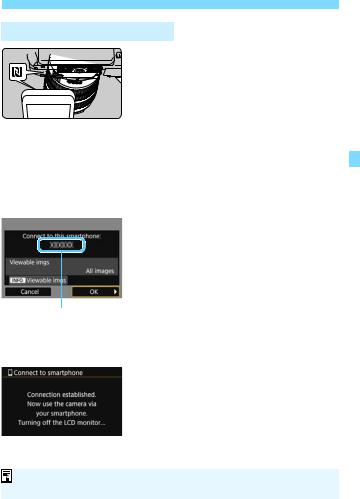
Connecting with the NFC Function
Connecting to a Smartphone
 1 Touch a smartphone to the camera.
1 Touch a smartphone to the camera.
If an image is being played back on
the camera, end the playback.
Touch the pmark on the smartphone to that on the camera.
When a message indicating the connection is displayed on the camera’s LCD monitor, communication can be established even if the smartphone is moved away from the camera.
Camera Connect starts on the smartphone and establishes a connection.
When the operation on the camera is completed in step 2, the Camera Connect Main window will appear.
The device name set on Camera Connect
2Save the settings.
When a connection is established, the screen on the left will appear on the camera’s LCD monitor. When connection settings are already saved, this screen will not appear and the LCD monitor will turn off.
To specify viewable images, press the <B> button. See step 5 on page 90 to set them.
Press the <Z> key to select [OK], then press <0>.
After a message is displayed, the camera’s LCD monitor will turn off.
You can check or change the device name on the setting screen of Camera Connect.
29

Connecting with the NFC Function
3Operate the Camera using Camera Connect.
Perform further operations using Camera Connect. For the operation procedure, see page 35.
The settings for communicating with a smartphone are now complete.
 NFC Function Cautions
NFC Function Cautions
When touching the smartphone to the camera, be careful not to drop the camera or smartphone.
Do not touch the smartphone to the camera with too much force. Doing so can scratch the camera or smartphone.
Just holding the smartphone close to the mark may not establish a connection. Be sure to touch the mark with the smartphone so that they come into contact with each other.
Recognition may be difficult depending on the smartphone. Touch slowly while changing the position or angle.
Another application on the smartphone may start depending on how you touch. Check the position of the pmark, then touch again.
A connection cannot be established via the NFC function while shooting with the camera, when the power switch is set to <k>, when there is no card, or when the LCD monitor is closed with the screen facing inward.
When touching the smartphone to the camera, do not leave anything between the camera and smartphone. In addition, when a case is attached to the camera or smartphone, communication may not be possible via NFC function.
When Battery Grip BG-E18 (sold separately) is attached, a connection cannot be established via the NFC function.
The camera cannot be connected to two or more smartphones at the same time.
By default, the connection settings via the NFC function are saved as the fourth setting (a setting dedicated to NFC connection) under the name [SET4(NFC)]. When you connect the camera to another smartphone via NFC, [SET4(NFC)] will be overwritten.
A connection can be established even when the camera’s power is in the auto power off state. However, if a connection cannot be established, cancel auto power off, then establish a connection.
30
